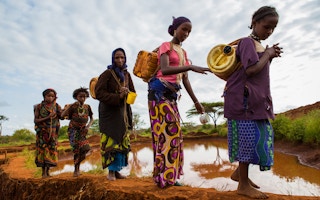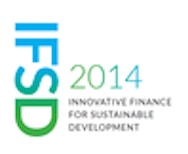These days, for just US$20 to $25, an ordinary investor looking to use their money for good can buy into funds that finance solar energy or green building projects worldwide, or be a micro-lender via the online platform Kiva to more than a million low-income borrowers around the world.
The concept of investing in sustainable development - building an economically, socially, and environmentally responsible world for current and future generations - has emerged in the recent decades, where previously the conventional model of charity and philanthropy dominated. And even where such investment options were available, they were inaccessible to smaller retail investors.
But today, governments, foundations, companies, and individuals are looking at new ways of financing sustainable projects, as well as getting them to deliver returns - not merely for profit but for the ability to channel some of these returns back into the project for the longer term.
These new financing models are also complemented by better methods to measure and reward the right outcomes, says Ms Claire Willers of The Gold Standard Foundation, the international carbon-offset body which is organising the inaugural Innovative Finance for Sustainable Development conference with Nexus Carbon for Development, a development-organisation cooperative.
The event, to be held on November 11 and 12 at Singapore’s National Library Building, aims to bring together foundations, private-sector and non-government organisations to discuss how mechanisms such as results-based finance can foster climate change mitigation and poverty alleviation, said Willers.
Results-based finance models pay out against agreed, specified outcomes, she explains. “To have any chance of limiting the global temperature rise to below two degrees Celsius [the safe threshold that scientists agree on to avoid dangerous climate change] whilst also ensuring that those who need it the most can mitigate and adapt to climate change, money needs to be funnelled to the right places and at scale.
“The days of donors giving money without knowing the results are long past. Investors are demanding more rigour and clarity around the benefits delivered by their investments, and are no longer prepared to pay before the evidence has been established that these benefits did actually occur,” she adds.
Meaningful investments: The Calvert Foundation
Investing for change is an approach that has worked out well for the Calvert Foundation, says its strategic initiatives officer Najada Kumbuli, who will speak about investor expectations at the conference.
The Calvert Group, whose founders later started the Foundation, has managed mutual funds that invest in socially and environmentally responsible companies since 1976.
In 1995, when the foundation began marketing its Community Investment Note, which has impacts in areas from global health to affordable housing, nuns and teachers were the first to buy in. Much like a mutual fund, the Community Investment Note is a portfolio of loans to nonprofits, microfinance instutions and social enterprises, which offers investors a fixed income.
“It’s that audience - they care about their money, but they also want to invest it in particular issues that they care about,” says Kumbuli. While the Note started out small - in its first 10 years the foundation sold about US$95 million worth of notes to investors - demand for the product has grown.
Today, the foundation has some US$400 million under management, and over the years has raised and lent roughly US$1 billion in capital.
“
It’s that audience - they care about their money, but they also want to invest it in particular issues that they care about.
Najada Kumbuli, Calvert Foundation strategic initiatives officer
Like most investments, there are risks involved, but these are spread over a diversified portfolio of funded projects and partner field organisations, and an ample loss reserve of up to 20 per cent is set aside for each project.
The results from these projects, such as the amount of greenhouse gas emissions mitigated, school seats created, or benefits to women, are measured and verified using a simple spreadsheet that is not overly burdensome for a borrower, Kumbuli says.
However, as the foundation is structured as a US non-profit, the Community Investment Note and newer products like a fund focused on women’s issues are not accessible to investors outside the United States.
Mobilising finance to tackle climate change
Meanwhile, Sindicatum group chief executive Assaad Razzouk, who will also be speaking at the conference, notes that it is important for new models of financing to be developed to tackle global climate change.
Sindicatum is a clean energy project developer which designs, owns and operates solar, waste-to-energy and other renewable energy projects around the world.
These projects, which provide energy without massive greenhouse gas emissions, help to slow the pace of man-made climate change. But clean-energy projects currently face “strong headwinds”, he says. Fossil fuels are frequently subsidised directly or indirectly to the tune of US$2 trillion a year globally, whereas climate financing of clean energy projects amounts to only about US$200 billion in comparison.
True environmental costs are also not always measured, he adds. A $2 toy made in a developing country may come bearing another $3 worth of invisible liabilities in air and water pollution and health impacts on workers.
Sindicatum’s innovation, Razzouk says, is not in its business model but in working out where renewable energy can be profitable amid these challenges.
“There’s nothing innovative or technologically challenging in what we do,” he says. “Renewable energy projects make money; but you have to navigate the landscape to find where they make money, and do them.”
In India, for instance, Sindicatum recovers sugar-cane residue from sugar mills for power generation, provides electricity to the mills, and sells the remainder to the state grid.
Razzouk adds that development financing to some extent depends on regulatory policy, such as feed-in tariffs where government agencies pay producers a favourable rate for clean energy.
But in fields like solar energy, even with the absence of feed-in tariffs, technological improvements and mass adoption and production mean that clean energy systems are becoming more cost-competitive with conventional fossil-fuel systems. This makes Sindicatum’s work easier, he explains.
Philanthropic organisations like conference sponsor blue moon fund are also coming up with new ways of doing business, says blue moon programme associate Tyler Gibson.
“Unlike any other foundation in the field, for example, we invest 100 per cent of our endowment in mission-driven investments so that we can maximize the impact of our work.” The fund’s endowment is invested in renewable energy companies, green bonds, and other sustainable investments, he adds.
The Calvert Foundation’s Kumbuli observes that more organisations are now building networks to link projects and borrowers with individual investors, government aid programmes, foundations, and companies. The Global Impact Investing Network is one such organisation; conference organiser Nexus is another.
Doesn’t that make for more competition? “The more the merrier,” she says. “Even if they target the same borrower, it provides the end consumer and borrower with more options and choices.”
Click here to find out more and register for the inaugural Innovative Finance for Sustainable Development conference on November 11-12 in Singapore.











